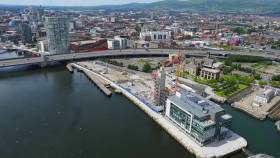Displaying items by tag: Belfast Waterfront
Miles Of Fun As 'Maritime' Mile Treasure Trail Launched in Belfast's Historic Waterfront
A new Maritime Mile Treasure Trail has been launched in Belfast Harbour bringing an exciting outdoor family experience aimed at encouraging locals and visitors to explore the city port's historic waterfront.
The joint initiative is between the Titanic Foundation and Belfast Harbour where the trail provides a waterfront experience for visitors to explore Belfast’s maritime & industrial heritage.
Titanic Foundation, the charity set up to preserve and promote Belfast’s maritime and industrial heritage including the development of Titanic Belfast, collaborated with Belfast Harbour on the trail. It was developed as part of the Foundation’s commitment to the development and promotion of Belfast’s iconic heritage waterfront as a seamless, accessible and vibrant destination for local people and visitors.
The treasure trail, which is available now until 6th November, is free!
There are 18 stops along Belfast’s iconic waterfront with questions, clues, facts and challenges all of which can be easily found on a series of information panels along the self-guided route.
There will be weekly prize draws as well as a main prize draw of a specially commissioned Maritime Mile painting by local artist and former Harland & Wolff employee Colin H. Davidson. There’s also a mini explorers version of the trail, with prizes also available. Everyone who completes the experience will get their very own Maritime Mile certificate.
For further information on the Maritime Mile Treasure Trail visit www.maritime-mile.com Follow Maritime Mile on Facebook and Instagram #MaritimeMile.
Broadcaster UTV to Relocate to Belfast's City Quays
#belfastlough - Belfast Harbour Commissioners has announced that ITV Broadcasting, owners of UTV are the latest tenant for its new £250 million City Quays 2 office development.
City Quays 2 is a new office led development of 20 acres on Belfast's waterfront. UTV is to relocate from its previous home at Havelock House which has been the local broadcasters base since its launch in Northern Ireland in 1959.
Belfast firm McLaughlin & Harvey has been appointed to fit-out the 11,400 sq ft space and create a modern broadcasting centre complete with HD studio, editing technology and office space for all of UTV’s staff. In addition to Grade ‘A’ office space, City Quays 2 will also include a four-star hotel operated by AC Marriott and a 900-space multi-storey car park.
UTV, which is taking the top floor of City Quays 2, is expected to begin broadcasting from its new studios in the summer of 2018.
Welcoming the move, Graeme Johnston, Belfast Harbour’s Property Director, said: “To confirm a household name such as ITV as the first tenant for City Quays 2 is excellent news and a great reflection on the flexibility of the office space available.”
“Other cities such as Manchester have benefitted from the creation of media quarters such as MediaCityUK and there is the potential to replicate that success here. NBC Universal is already based in City Quays 1, the Belfast Telegraph is located nearby in Clarendon Dock and both the Belfast Harbour Film Studios and Titanic Studios are within easy reach.”
“City Quays 2 has been one of the largest speculative office developments in Northern Ireland in recent years and could ultimately accommodate 1,000 workers.”
Speaking earlier in the year Terry Brennan, Head of News and Programming at UTV said: “We are delighted to have secured the entire eighth floor of this prestigious new building which is in a prime location in central Belfast for our new UTV headquarters. We can see how beneficial this location will be, in terms of the surrounding amenities and transport links for our modern news operation.
“This is also a significant milestone in UTV’s history and represents a multi-million pound investment by ITV since it acquired UTV just over a year ago. We aim to be operational at the new site by the middle of next year, when the detailed technical work will be complete to fit out the new HD studios, edit suites, corporate offices and news, administration, finance and sales areas for our staff.”






























































